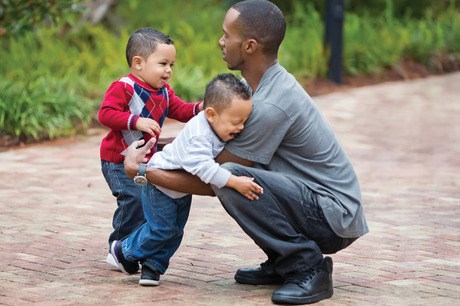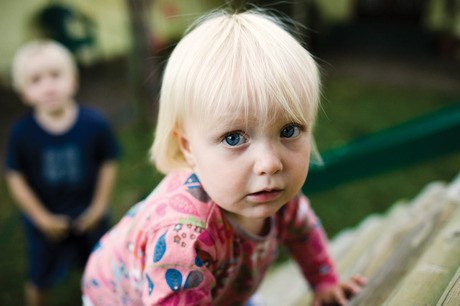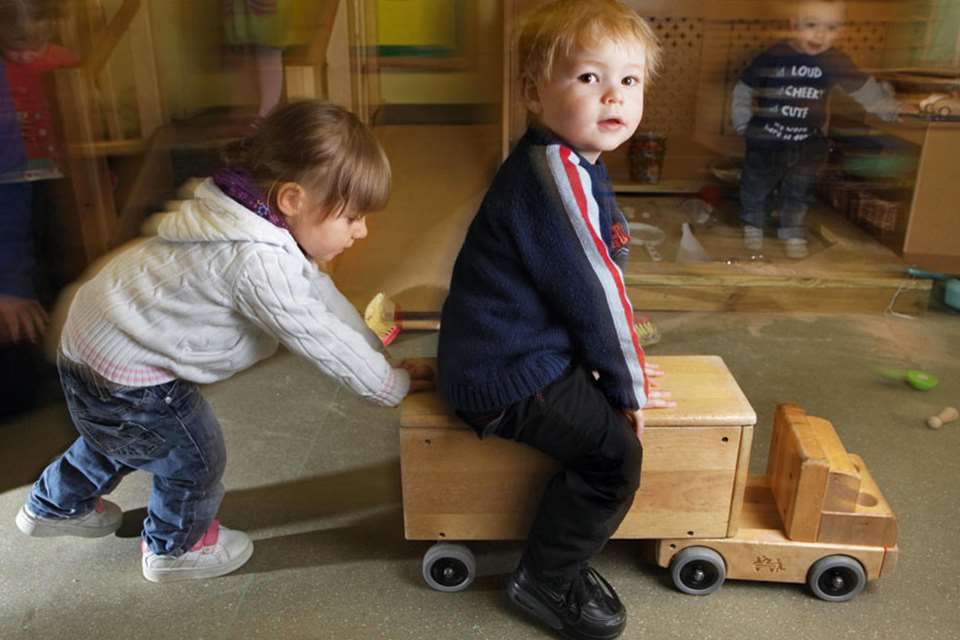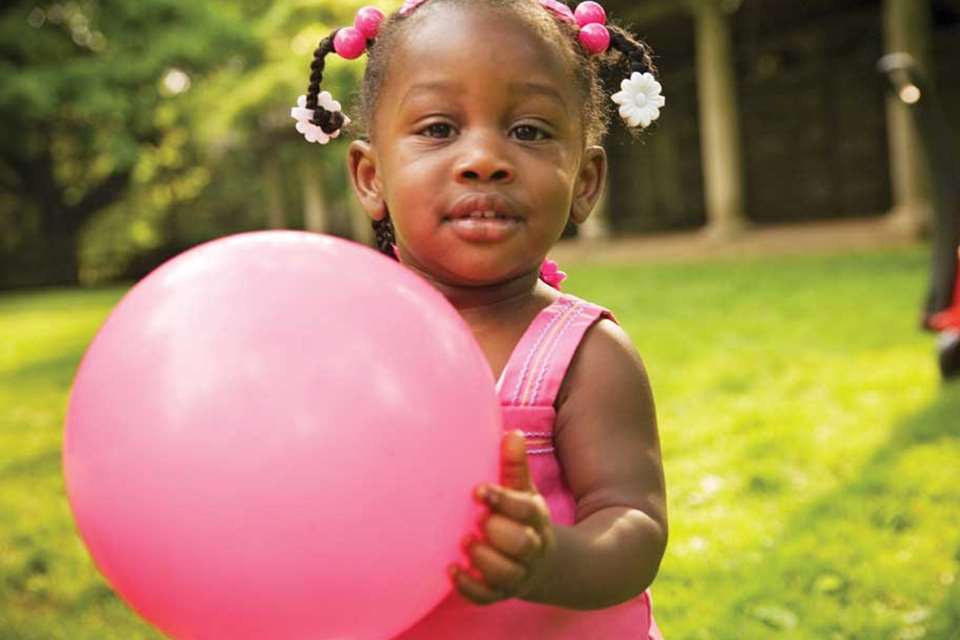Positive Relationships: Behaviour - All too much?
Julia Manning-Morton
Monday, February 9, 2015
In the second instalment of her series on two-year-olds' development and behaviour, Julia Manning-Morton looks at why practitioners should be aware of the emotional roots behind children's actions.

Two-year-olds are often labelled as 'terrible twos' who need 'taming'. They are stereotyped as egocentric people who flit from one thing to another wreaking havoc in their wake, are arbitrarily defiant and bite and have tantrums. So, their behaviour is often termed 'challenging', and parents and practitioners alike veer between digging in their heels in a determined effort to be in control or throwing in the towel and giving up.
Two-year-olds experience their feelings with great intensity, which often prompts passionate expressions of excitement, sadness, anger or joy that easily overpower their self-control and lead to impulsive behaviours and emotional collapses.
To understand what gives rise to these behaviours, we have to consider that two-year-olds are frequently meeting new, challenging and often hard-to-understand experiences that are outside their control, particularly when they start attending an early years setting for the first time. If we compare the number of new situations that two-year-olds encounter regularly with our own, we can appreciate that such an ever-changing, out-of-my-control life will inevitably lead to mood and behaviour swings.
For a good insight into the roots of two-year-olds' behaviours, it is also useful for practitioners to understand the very gradual maturation of the area of the brain that processes the conscious control of emotions.
BRAIN DEVELOPMENT
Our consciously felt and understood emotions are processed in the pre-frontal lobes of the cortex of the brain while our unconscious basic emotions are governed by the limbic system at the centre of the brain.
The limbic system includes the amygdala, which Joseph LeDoux (1998) describes as our 'emotional sentinel'. When the brain receives information that is threatening in some way, rather than being transmitted to the cortex for consideration, it travels directly to the amygdala, which releases hormones and chemicals that trigger the fight-or-flight response. Two-year-olds who feel anxious, bewildered, scared or angry will, therefore, often respond by running off, hitting out or having a 'tantrum'.
Feelings of happiness and excitement also trigger hormones that increase energy for vigorous action - after all, we talk about 'jumping for joy'. While sadness results in slowing down and withdrawing, so a two-year-old in this state may be clinging and whining. The close link between emotional and physical feelings is clear here: a two-year-old who is tired, hungry or cold will also have a strong emotional response.
This is because at two years old, the development of the connections in the area of the cortex where emotions are consciously felt, understood and regulated are in the very early stages of development.
As neural pathways are firmed up, as a result of the child's experiences of the world and relationships, they send chemical inhibitors to the amygdala, thereby gradually developing the capacity for emotional control (Gerhardt, 2004). This process, though, is at its early stages and continues throughout childhood until adolescence and early adulthood (Eliot, 1999).
Understanding that self-control develops gradually and can fluctuate enables practitioners to have appropriate expectations, one of which is to expect that two-year-olds may show self-control in one situation but not in another, just like adults on a diet.
An example from Manning-Morton and Thorp (2015) explains how 'although Marco showed self-control and resisted the temptation to hit out at Lenny this morning, it does not mean he could always do so. Later that day, for example, he was unable to resist taking raisins from another child's plate'.
Another important aspect of brain development is that the amygdala receives and stores the potent emotional but unconscious memories of the first few years of life. These memories can be triggered by bodily and sensory experiences. Therefore, particular sounds, smells or types of touch can then also cause the fight-or-flight response. This applies to caring adults as well as children and, although adults may be able to control their responses, the provocation of such memories can add to adults' stress levels.

ADULT SUPPORT
Given the aspects of development outlined above, practitioners encountering the strong emotional outbursts of two-year-olds need to consider carefully their understanding of the triggers for the behaviours and their responses to them.
A behaviourist approach of naughty steps, thinking time, time-out chairs or sticker charts do not help children to sufficiently understand their feelings and behaviours. Neither does such an approach consider the kind of distressing early experiences that may be triggering a child's behaviour (Manning-Morton and Thorp, 2015).
It is close, empathetic key person relationships that support effective emotional learning and enable self-restraint and social understanding. Within this relationship, practitioners need to feel comfortable supporting a range of emotional expression in children. This is not always easy, as being in touch with young children's powerful emotions can provoke strong, often uncomfortable feelings in adults too, so some practitioners will be more or less comfortable with children expressing anger or excitement, according to their own early emotional learning. Practitioners, therefore, also need effective support and supervision to be able to reflect on these feelings.
This is important because containing and comforting distressed children through gentle holding, providing words for feelings and calmly and gently offering explanations, empathy and reassurances is a key professional skill of early childhood practitioners.
When a child's feelings are empathised with, calmed and put into words by another, the child experiences their feelings as being understood and understandable, so they become more able to recognise and understand feelings in others and also develop an integrated understanding of themselves as a person.
Practitioners can also support two-year-olds' emotional learning by making sure that they talk about people's feelings in meaningful contexts. Being involved in children's play and having small 'key group' times means that opportunities for naming a wide range of emotions and discussing emotional responses are created.
When children can understand and are able to put words to feelings, they not only become more able to express emotions but they are also more able to reason solutions to problems across a range of circumstances.
Provision of play opportunities that are open-ended and child-directed, and in which children can use materials in a range of ways, will also give two-year-olds with limited spoken language a chance to express their feelings less directly: the pummelling of clay or dough or the soothing qualities of water are just two examples of this. Organising such play opportunities based on observations of individual children's emotional literacy should be a central focus of curriculum planning.

OUT OF FRUSTRATIONS
If practitioners consider all the complex and perplexing learning situations that two-year-olds encounter, they will understand, have empathy with and even expect the tantrums or emotional collapses that young children sometimes have. It is inevitable that sometimes a two-year-old's fragile ego will shatter in the face of their intense feelings arising from the many frustrations and misunderstandings they encounter.
Two-year-olds can experience these strong feelings as being overwhelming, frightening and never-ending unless they get prompt empathetic responses from a caring adult.
A practitioner who responds by expressing their empathy and staying close by to cuddle (if wanted) and reassure the child when the rage is dying down will be providing the containment that young children need at such times.
The child then learns that distress and discomfort do not last forever and experiencing someone else managing the feelings for them means they learn gradually to able to manage these feelings themselves.
Sometimes it is hard to discern whether a tantrum is an emotional collapse due to cumulative frustrations or a ploy for getting their wants supplied - a strategy that may have proved to be effective in the past.
A practitioner may be critical of a child for this, seeing the behaviour as manipulative, but a more positive approach is to help the child realise that it is ineffective in this group and to show them what is effective. This means acknowledging verbally what the child wants and how cross they are because they cannot have it. For example, 'It's very cold today, so you have to wear your coat or you will soon get very cold. Which coat would you like to wear? This nursery coat with the nice big pockets or your own coat with the teddies on? I'll leave them both beside you so you can choose.'
Giving the child some power in the situation within the boundaries in this way can help restore some of the child's dignity and composure and having clear, reasonable boundaries that are implemented and reinforced consistently helps two-year-olds to feel safe and contained.
TIME TO RE-EVALUATE?
If the two-year-olds in a group often have emotional collapses, the first thing for a team to do, as well as addressing individual children's needs, is to re-evaluate its practice and provision. Observe what triggers tantrums:
- Are the routines of the day flexible? Are children warned about changes in activity and given time to finish what they are doing or the choice to return to it later?
- Is the environment over-stimulating? Is it a large, noisy group? Where can a child go for some quiet solitude?
- Are key persons consistently available to their key children, playing with them at their level?
- Do all adults engage in positive interactions with children, noticing pro-social behaviours?
(From Manning-Morton and Thorp, 2003, 2006).
MORE INFORMATION
- Early Intelligence: how the brain and mind develop in the first five years of life by L Eliot (1999), Penguin
- Key Times: a framework for developing high-quality provision for children from birth to three years by J Manning-Morton and M Thorp (2006), OUP
- Key Times for Play: the first three years by J Manning-Morton and M Thorp (2003), OUP
- The Emotional Brain: the mysterious underpinnings of emotional life by J Ledoux (1998), Touchstone
- Two-Year-Olds in Early Years Settings: journeys of discover by J Manning-Morton and M Thorp (2015), OUP
- Why Love Matters: how affection shapes a baby's brain by S Gerhardt (2004), Brunner-Routledge









